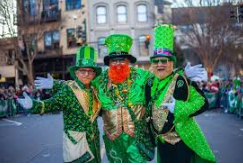Lucky the Leprechaun Isn’t Just a Marketing Strategy – or is he?
Generation after generation, story after story; Ireland’s rich history has been kept alive for ages. All over the globe, people consistently celebrate the culture, from playing Irish sports to admiring their gorgeous landscape. One of the most recognized parts of the culture – besides the famous drinks – is medieval literature, which has traveled through Europe and across the Atlantic Ocean to the Americas. Legend has it that even the smallest of creatures described in the tall-tales have become one of the biggest mascots for the country. According to HISTORY.com,
“Irish folklore, rich with medieval accounts of dark fairies and goblins, portrayed the mythical humanoids—always described as no more than two or three feet tall—as fearful beings.” They’re viewed as a lucky charm, but their lore goes beyond the cereal box.
St. Patrick is NOT a Leprechaun.
St. Patrick’s Day is a global holiday that celebrates the patron saint Patrick and the beauty of Irish culture. While Patrick was not an Irish man, the impact he made in the country was profound for his time. The saint, born in the fourth century, was first a slave. When he escaped to become a priest, he returned back to Ireland to spread Christianity. He promoted peace to all, and even when religious tension broke out between Protestants and Catholics, he remained the peace maker of both. He was made an official Saint on March 17th, and that day since then has been known as St. Patrick’s day. A very religious day for Irish men and women, people would sit and pray, solemnly and soberly. However, when the holiday reached America in 1762, the festivities changed; instead of silent prayers, there were green beer, green rivers and lakes, and obnoxious parties. This came as a huge culture shock Ireland, but eventually the frivolous celebrations trickled its way over to Ireland, and they joined in on the fun.
One major difference between the USA and Ireland’s holiday festivities is one that surprises the surrounding countries the most. And the ironic thing about it is that the difference itself isn’t really that big at all.
Who are the leprechauns, and why do they want my money?
A long time ago, around the medieval eighth century, leprechauns inhabited the dark seas rather than the ends of rainbows. Leprechauns were originally sadistic water-sprites, and in early fables such as The Adventures of Fergus Son of Leti, they attempted to drown the mighty king, all for the riches they would gain. However, in his courageous efforts, King Fergus defeated the sprites and lived to tell the tale. In order to repay the king without losing precious money, the creatures offered him three wishes, similar to the famous Genie from Aladdin. In later versions of the leprechaun tales, this offer still stands, but only to those that can capture the cobblers.
The frightening reputation of the sprites terrified young Irish children, so the parents had to think of a new look. In the 1800’s, the leprechauns shifted from fantasy creatures to tiny, red-bearded men. Decked in green from head-to-toe, the image of leprechauns became less alarming to kids. Their jobs switched to innocent shoemakers, but their cheeky minds never changed through evolution.
Fables always intended to teach children a lesson. The Tortoise and the Hare proves that the slow and the steady win the race. The Boy Who Cried Wolf teaches the importance of telling the truth. All kinds of leprechaun stories share a similar lesson – uncontrollable greed will trap you in the end.
Maybe some people should pay more attention!
St. Paddy’s Day and Leprechauns Collide… Sort Of.
While leprechauns originated in Irish folklore, it was the American’s that made them a mascot for St. Patrick’s Day. Leprechauns have no part of the holiday at all in Ireland, actually. Coincidentally, St. Patrick has no significance in America’s celebrations.
“While the day was marked with more of a religious framing and solemnity in Ireland until well into the 20th century, in America it became the cultural and boisterous celebration it is today, marked by plenty of people without a trace of Irish heritage,” says Deepti Hajela, staff writer of the Associated Press. Because of this, the true meaning of St. Patrick’s Day was lost in translation. In true American fashion, the holiday became heavily commercialized as the years went on. The day consists of drinking green beer, pinching gingers, and sporting green, shamrock-covered shirts. People dyed the Chicago River green. Leprechaun decor has filled every store. Children try to catch leprechauns in hopes of receiving wishes, money, or treats. Instead of honoring an important historical figure of Ireland, the United States celebrates the stereotypical Irish narrative. The true meaning of St. Patrick’s Day is lost amongst most Americans.
Ireland, however, celebrates in a quieter way to pay respect to the patron saint. While they now have parades and marches to commemorate St. Patrick, the citizens of Ireland don’t typically drink. In fact, until the 1960’s, Irish pubs around the countries were closed because the holiday is religious. Schools and banks closed along with them, that still being in affect to this day. It’s all so different in America – why would that be?
It all comes down to the differences in culture. With countries that have been established as long as Ireland has, the history of the country is more valuable. It must be kept safe. This includes the vital people, events, stories…if the history isn’t remembered, then lessons aren’t learned. The United States is relatively young for a country – it’s a wild teenager compared to the elders.
It may seem disappointing that leprechauns aren’t as vital to the holiday as many people presumed, but that doesn’t mean setting a trap can’t be fun. What’s most important to remember is the lessons leprechauns teach rather than how cute the figurine will look on the fireplace.









